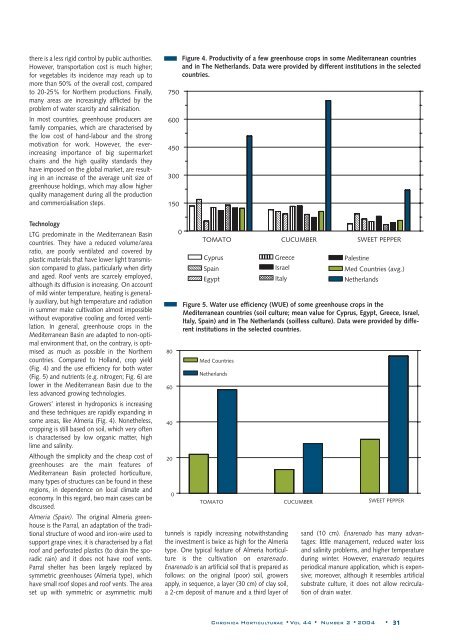Number 2 - 2004 - Acta Horticulturae
Number 2 - 2004 - Acta Horticulturae
Number 2 - 2004 - Acta Horticulturae
Create successful ePaper yourself
Turn your PDF publications into a flip-book with our unique Google optimized e-Paper software.
there is a less rigid control by public authorities.<br />
However, transportation cost is much higher;<br />
for vegetables its incidence may reach up to<br />
more than 50% of the overall cost, compared<br />
to 20-25% for Northern productions. Finally,<br />
many areas are increasingly afflicted by the<br />
problem of water scarcity and salinisation.<br />
In most countries, greenhouse producers are<br />
family companies, which are characterised by<br />
the low cost of hand-labour and the strong<br />
motivation for work. However, the everincreasing<br />
importance of big supermarket<br />
chains and the high quality standards they<br />
have imposed on the global market, are resulting<br />
in an increase of the average unit size of<br />
greenhouse holdings, which may allow higher<br />
quality management during all the production<br />
and commercialisation steps.<br />
750<br />
600<br />
450<br />
300<br />
150<br />
Figure 4. Productivity of a few greenhouse crops in some Mediterranean countries<br />
and in The Netherlands. Data were provided by different institutions in the selected<br />
countries.<br />
Technology<br />
LTG predominate in the Mediterranean Basin<br />
countries. They have a reduced volume/area<br />
ratio, are poorly ventilated and covered by<br />
plastic materials that have lower light transmission<br />
compared to glass, particularly when dirty<br />
and aged. Roof vents are scarcely employed,<br />
although its diffusion is increasing. On account<br />
of mild winter temperature, heating is generally<br />
auxiliary, but high temperature and radiation<br />
in summer make cultivation almost impossible<br />
without evaporative cooling and forced ventilation.<br />
In general, greenhouse crops in the<br />
Mediterranean Basin are adapted to non-optimal<br />
environment that, on the contrary, is optimised<br />
as much as possible in the Northern<br />
countries. Compared to Holland, crop yield<br />
(Fig. 4) and the use efficiency for both water<br />
(Fig. 5) and nutrients (e.g. nitrogen; Fig. 6) are<br />
lower in the Mediterranean Basin due to the<br />
less advanced growing technologies.<br />
Growers’ interest in hydroponics is increasing<br />
and these techniques are rapidly expanding in<br />
some areas, like Almeria (Fig. 4). Nonetheless,<br />
cropping is still based on soil, which very often<br />
is characterised by low organic matter, high<br />
lime and salinity.<br />
Although the simplicity and the cheap cost of<br />
greenhouses are the main features of<br />
Mediterranean Basin protected horticulture,<br />
many types of structures can be found in these<br />
regions, in dependence on local climate and<br />
economy. In this regard, two main cases can be<br />
discussed.<br />
Almeria (Spain). The original Almeria greenhouse<br />
is the Parral, an adaptation of the traditional<br />
structure of wood and iron-wire used to<br />
support grape vines; it is characterised by a flat<br />
roof and perforated plastics (to drain the sporadic<br />
rain) and it does not have roof vents.<br />
Parral shelter has been largely replaced by<br />
symmetric greenhouses (Almeria type), which<br />
have small roof slopes and roof vents. The area<br />
set up with symmetric or asymmetric multi<br />
80<br />
60<br />
40<br />
20<br />
0<br />
0<br />
TOMATO<br />
Cyprus<br />
Spain<br />
Egypt<br />
Med Countries<br />
Netherlands<br />
TOMATO<br />
CUCUMBER<br />
Greece<br />
Israel<br />
Italy<br />
CUCUMBER<br />
Palestine<br />
SWEET PEPPER<br />
Med Countries (avg.)<br />
Netherlands<br />
Figure 5. Water use efficiency (WUE) of some greenhouse crops in the<br />
Mediterranean countries (soil culture; mean value for Cyprus, Egypt, Greece, Israel,<br />
Italy, Spain) and in The Netherlands (soilless culture). Data were provided by different<br />
institutions in the selected countries.<br />
tunnels is rapidly increasing notwithstanding<br />
the investment is twice as high for the Almeria<br />
type. One typical feature of Almeria horticulture<br />
is the cultivation on enarenado.<br />
Enarenado is an artificial soil that is prepared as<br />
follows: on the original (poor) soil, growers<br />
apply, in sequence, a layer (30 cm) of clay soil,<br />
a 2-cm deposit of manure and a third layer of<br />
SWEET PEPPER<br />
sand (10 cm). Enarenado has many advantages:<br />
little management, reduced water loss<br />
and salinity problems, and higher temperature<br />
during winter. However, enarenado requires<br />
periodical manure application, which is expensive;<br />
moreover, although it resembles artificial<br />
substrate culture, it does not allow recirculation<br />
of drain water.<br />
CHRONICA HORTICULTURAE •VOL 44 • NUMBER 2 • <strong>2004</strong> • 31
















